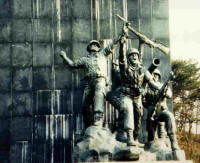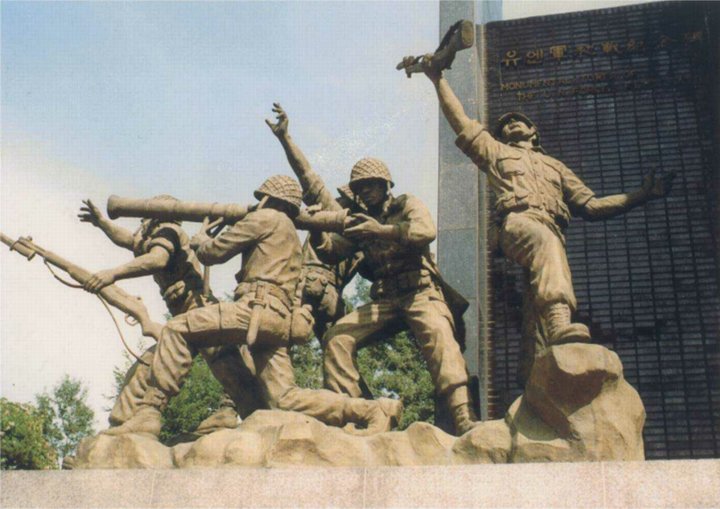From: http://korea50.army.mil/history/factsheets/tfsmith.shtml
Task Force Smith was the first U.S. Army ground maneuver unit to enter combat in Korea. On June 30, 1950, President Harry S. Truman authorized General Douglas MacArthur to commit ground forces under his command to Korea, and MacArthur in turn instructed Lieutenant General Walton H. Walker, commander of the Eighth Army, to order the 24th Division there. Early on July 1, the Eighth Army provided for a makeshift infantry battalion of the 24th Division to be flown to Korea in the six C-54 transport aircraft available. The remainder of the division followed by water. The initial force was to make contact with the enemy and fight a delaying action. This was Task Force Smith, “that arrogant display of strength” that MacArthur hoped would fool the North Koreans into thinking a larger force was at hand. Some officers assumed that even this small force would give the North Koreans pause once they realized whom they were fighting.
Task Force Smith was named for Lieutenant Colonel Charles B. Smith, commanding officer, 1st Battalion, 21st Regiment, 24th Infantry Division. It comprised 406 officers and men: half of the battalion headquarters company, two understrength rifle companies (B and C), a communications section, a recoilless rifle platoon and two mortar platoons. In addition to its rifles, the task force had two 75mm recoilless rifles, two 4.2-inch mortars, six 2.36-inch “bazooka” rocket launchers and four 60mm mortars. Each man was issued 120 rounds of ammunition and two days’ C-rations. Most of the men were 20 years old or less; only one sixth had seen combat.
The men of Task Force Smith left Japan on the morning of July 1. Major General William Dean, 24th Division commander, ordered Smith to block the main road to Pusan as far north as possible.
The men landed at an airfield near Pusan and moved north to Taejon by train, arriving there on the morning of July 2. Smith ordered his men to rest while he and his staff officers drove north to reconnoiter. About three miles north of Osan, Smith found an ideal blocking position, a line of low rolling hills about 300 feet above the level ground. This position also commanded the main railroad line to the east, and afforded a clear view to Suwon, about eight miles north.
On July 4, the task force was joined at Pyongtaek by part of the 52d Field Artillery Battalion: half each of headquarters and service batteries, and all of A Battery with six 105mm howitzers, 73 vehicles, and 108 men under the command of Lieutenant Colonel Miller O. Perry. In the late afternoon of July 4, Smith, Perry and some others made a final reconnaissance of the position that Smith had selected. The combined infantry and artillery moved out of Pyongtaek by truck, arriving at the position about 3:00 a.m. In cold, rainy weather they dug foxholes. The American position extended about a mile on both sides of the Suwon-Osan road. The troops laid telephone lines to four of the howitzers, placed in a concealed position some 2000 meters to the south. One 105mm howitzer was positioned halfway between the battery and the infantry position in order to cover the length of the road and serve as an antitank gun. Volunteers from the artillery made up four .50-caliber machine gun and four 2.36-inch bazooka teams and joined the infantry position to the north. The infantry vehicles were located just to the south of their position; the artillerymen had concealed their trucks just north of Osan. The Americans were vulnerable to enemy flanking attacks, lacked the means to stop enemy tanks and were without reserves.
At dawn on the July 5th, Smith ordered his artillery, mortars and machine guns to conduct registration fire. Steady rain precluded air support. Further, because of earlier, disastrous cases of U.N. aircraft hitting friendly ground forces, all air support that day was confined to north of Suwon. Shortly after 7:00 a.m., movement was detected to the north. Within half an hour, a column of eight North Korean T-34 tanks, part of the 107th Tank Regiment of the 105th Armored Division, approached across the open plain from Suwon. At 8:00 a.m. the artillery received a request for a fire mission and at 8:16 a.m. the first American ground fire of the Korean War was opened against the tanks, about 2,000 yards in front of the infantry position. The high-explosive (HE) rounds had no effect on the tanks, which had their hatches closed. The battery had only six armor-piercing high-explosive antitank HEAT rounds available (one-third of the total on hand when the 52d was loading at Sasebo, Japan), all of which were given to the single howitzer forward. Antitank mines would have stopped the enemy advance, but there were none in Korea. Smith ordered 75mm recoilless rifle fire withheld until the column of tanks reached the 700-yard range. The recoilless rifle crews scored direct hits, again without apparent effect. The tanks stopped and opened fire with their 85mm main guns and 7.62mm machine guns. Second Lieutenant Ollie Connor fired twenty-two 2.36-inch bazooka rounds at the enemy armor, all from close range, including a number at the more vulnerable rear ends of the T-34s, but there was no apparent damage. The 2.36-inch rounds could not penetrate the armor of the T-34. Smith later said he believed that the rounds had deteriorated with age. The 3.5-inch bazooka round would have been effective, but again, there were none in Korea.
As they approached the lone 105mm gun forward, the two lead tanks were hit and damaged, probably by HEAT rounds. One caught fire and two of its crew members came out of the turret with their hands up; a third came out with a burp gun and fired it against an American machine gun position beside the road, killing an assistant gunner, the first American ground fatality of the Korean War. The third tank through the pass, however, knocked out the forward 105mm howitzer with its cannon fire. The other tanks swept on south past the artillery battery, which fired HE rounds against them. One tank was disabled and ultimately abandoned.
By 10:15 a.m. the last of 33 North Korean tanks had driven through the American position, killing or wounding some 20 Americans by machine gun and shell fire. Most of the vehicles parked immediately behind the infantry position were destroyed. The wire communications link with Battery A had been chewed up by the tanks as they passed. Fortunately there were no accompanying infantrymen; the tankers were unable to locate the artillery battery firing on them and the T-34s rumbled on toward Osan. A lull of about an hour followed. The steady rain continued and the defenders used the time to improve their position. At about 11:00 a.m., three more tanks were sighted advancing from the north. Behind them was a column of trucks, followed by miles of infantry on foot. These were men of the 16th and 18th regiments of the North Korean 4th Division. The column apparently was not in communication with the tanks that had preceded it.
It took about an hour for the head of the column to reach a point about 1,000 yards from the American position, when Smith ordered fire opened. American mortars and machine guns swept the enemy column causing heavy casualties but did not stop the three tanks. These advanced to within 300 yards and raked the ridge with shell and machine gun fire. Smith had no communication with the artillery battery, which he believed had been destroyed.
Smith held his position as long as he dared, but casualties mounted rapidly. His men were down to less than 20 rounds of ammunition each and the enemy threatened to cut off the position. The enemy tanks were to the rear of the American position, and Smith consolidated his force in a circular perimeter on the highest ground east of the road. The enemy was now using mortar and artillery fire. About 4:30 p.m., Smith ordered a withdrawal, remarking, “This is a decision I’ll probably regret the rest of my days.” The plan was for an orderly leap-frogging withdrawal, with one platoon covering another. Under heavy enemy fire, the poorly-trained American troops abandoned weapons and equipment in sometimes precipitous flight. Not all of them had received word of the withdrawal, and it was at this point that the Americans suffered most of their casualties. When they reached the battery position Smith was surprised to find it intact with only Perry and one other man wounded. The artillerymen disabled the five remaining howitzers by removing their sights and breechblocks. Then all walked to the outskirts of Osan where they recovered most of their trucks that had been hidden earlier. South of Osan the Americans were forced to detour, and some stragglers were picked up. Fortunately there was no enemy pursuit. At Chonan, only 185 men of the task force could be accounted for. Subsequently, C Company commander Captain Richard Dashmer came in with 65 more, bringing the total to 250. More trickled back to American positions during the following week. One survivor even made it from the west coast by sampan, or small, flat-bottomed Chinese boat, to Pusan. In the battle approximately 150 American infantrymen were killed, wounded, or missing. All five officers and ten enlisted men of the forward observer liaison, machine gun and bazooka group were lost. North Korean casualties in the battle before Osan were approximately 42 dead and 85 wounded; four tanks had been destroyed or immobilized. The enemy advance was delayed perhaps seven hours.
Cont’d




